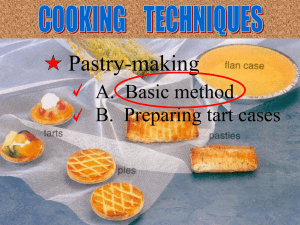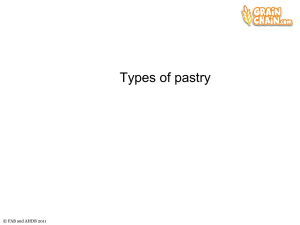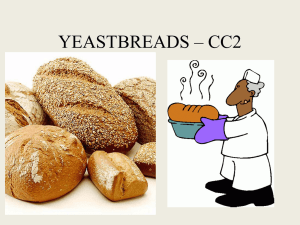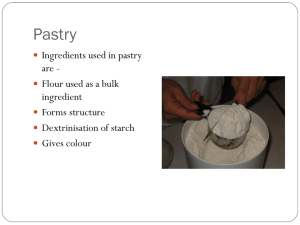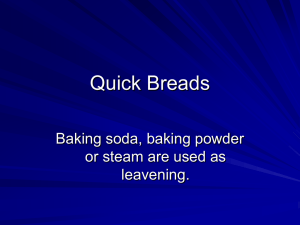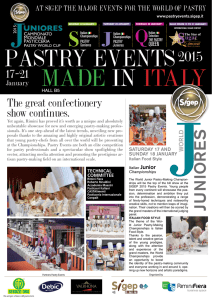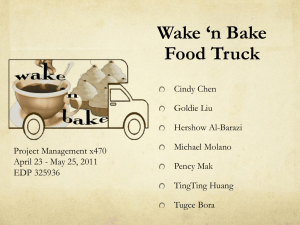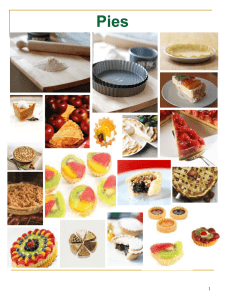Pies
advertisement
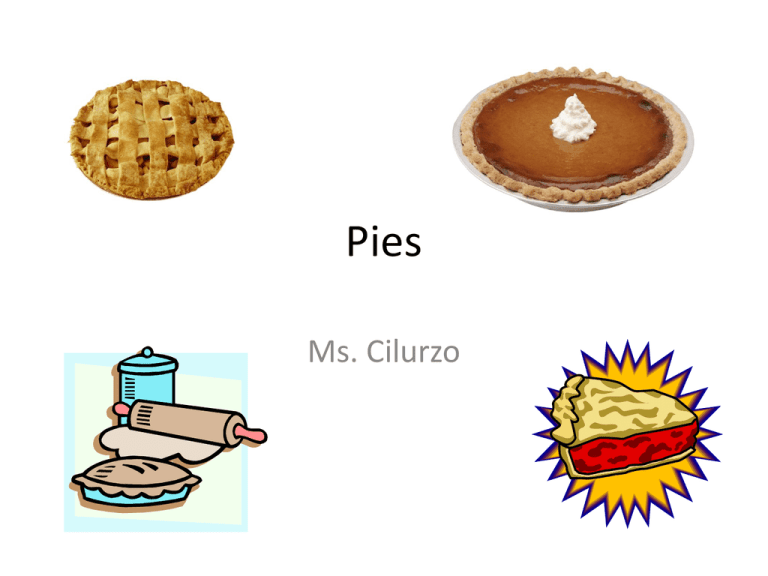
Pies Ms. Cilurzo Objectives: • • • • • • • • Understand the functions of the basic ingredients used in pastry. Describe the advantages and disadvantages of a convenience food. Explain how to handle pastry dough to prevent toughness. Differentiate between a convenience food and a homemade product. Demonstrate how to prepare a variety of pies. Identify the function of each ingredient used in the preparation of puff pastry. Demonstrate how to prepare choux pastry. Explain how puff pastry can be used for main dishes, desserts and appetizers. Class Work • Textbook: page 648-655 • Answer on page 656 under “Check Your Knowledge” questions 1-4, 7-13, 15-23. What is a convenience food? • Commercially prepared food designed for ease of consumption. • Ready-to-eat foods • Pros vs. Cons Pros vs. Cons • Pros: – – – – – Faster and Easier Saves Time Less Preparation Less Cooking Time Can be stored longer than fresh food • Cons: – More Expensive – Loss of nutrients during processing – Harder to control fat, sugar, sodium levels when it’s not homemade – Usually higher levels of sodium, saturated fats, and added sugar Types of Pie Fillings • 1. Fruit: sliced fruit combined with sugar and a starch thickener such as flour or corn starch. – Examples: apple pie, blueberry pie, cherry pie • 2. Cream: consists of eggs, milk, and starch thickener (corn starch), filling is like a pudding. – Examples: banana cream, chocolate cream, lemon cream, coconut cream • 3. Custard: filling is like a pudding, similar in texture to cream, made with milk and eggs – Examples: pecan pie, pumpkin pie, Bavarian cream, éclairs • 4. Savory: contains cooked meat, poultry, seafood or vegetables in a thickened sauce – Examples: shepherd's pie, chicken pot pie, quiche Cream Vs. Custard • Cream pies contains cooked custard poured into a pre-cooked pie crust. Both are baked and prepared separately. • Custard pies contains uncooked custard poured into a raw pie crust and are baked together. Types of Pie Crusts 1. Crumb Crust: made of crushed cookies or crackers, melted butter and sometimes sugar 2. One Crust Pie: crust is on the bottom only. Either the crust and pie filling are baked together or the crust is baked empty or blind and prepared filling is added later 3. Two Crust Pie: crust is on the bottom and the top and the filling is in the middle Pastry Dough Ingredients • Four ingredients: flour, water, fat and salt • Flour: Forms structure. All purpose flour or cake flour for added lightness and a softer dough • Water: Usually ice-cold water is used. Ice-cold water helps keep the fat from melting during mixing which is needed for a flaky texture • Fat: – Tenderizes and adds flavor – Vegetable shortening and lard make the flakiest crust because it is pure fat – Butter makes a crumbly crust because of the water content – Oil creates a dry, grainy crust and is less flaky • Salt: Adds Flavor Docking • To keep a pie shell from puffing up when baking, you can: – Use a fork to poke small holes all over the dough before putting it into the oven – Line the dough with aluminum foil and fill with dried beans Overmixing • If the pastry is mixed too much, the particles will break down • If handled too much, the particles melt from the heat in your hands • All of this work overdevelops the gluten, transforming the texture from light to leathery and tough. If the dough becomes cracked… • Patch or reshape it by cutting of a piece the size needed from an area where you have extra dough • With cold water, slightly moisten the area to be repaired • Place the patch on the dough and press firmly Blind Baking • When the pie shell is cooked by itselft without any filling What are two ways to prevent dough from shrinking? • 1) let it rest (usually few hours to overnight) • 2) don’t stretch it Preparing a pie crust • 1. Cut the fat into the flour and salt with a pastry blender until the mixture resembles small peas • 2. Add water 1 tablespoon at a time, mixing lightly with a fork after each addition until mixture is moist. • 3. Form a ball of dough that is neither crumbly (too dry) or sticky (too wet) • 4. Cover dough with plastic wrap so it doesn’t try out • 5. Rest dough so gluten can form. • Preparing the Pastry Dough Rolling the Pastry Dough • 1. Sprinkle the works surface and rolling pin with flour or place the dough between two pieces of wax paper • 2. Press the ball of the dough to flatten it slightly • 3. Gently roll the dough from the center out in all directions until its 2 inches longer than pie plate • 4. Transfer dough to pie plate by folding the dough in half or quarters and lifting it gently • 5. Push the dough gently to the bottom and sides • 6. Flute the edges with a fork • Rolling the Pastry Dough Questions • 1. What is a pie? • 2. Describe the following kinds: fruit, cream, custard and savory • 3. What are the four main ingredients in pastry dough? • 4. Why should water be ice cold when making pastry dough? • 6. Compare crusts made with these fats: vegetable shortening or lard, butter or cream cheese and oil Questions • 7. How do you mix pastry dough? • 8. Why should pastry dough be handled as little as possible? • 9. How do you roll pastry dough? • 10. What are two ways to keep pastry dough from shrinking? • 11. How can you repair a crust that is missing dough? • 12. What is a fluted edge? • 13. How is the top crust for a two-crust pie made? Questions • 15. What is a pie shell? • 16. What is the purpose of docking? • 17. What ingredients are commonly used in a crumb crust? • 18. What type of crust would you choose for these pies and why? A) banana cream B) cherry C) Pumpkin D) apple E) chicken pot pie • 19. What is a turnover? • 20. How do tarts differ from pies? Questions • 21. What can you do if you think a pie or tart might bubble over while baking? • 22. How can you prevent a crust from becoming soggy on the bottom?
